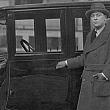Financial Meltdown in Michigan
The effects of the Great Depression increased gradually and by 1931 banks in Toledo, Ohio, Chicago, and New York failed, unable to meet their obligations. Michigan followed in early 1933.
When the financial conglomerates sought private help, the Reconstruction Finance Corporation (RFC) and President Herbert Hoover were reluctant to become involved once they discovered the poor practices and lax oversight the banks had exercised over their financial portfolios. Auto magnate Henry Ford refused to help. Because the presidential inauguration was not until March, President-elect Franklin Roosevelt proved reluctant to sign off on a perceived bailout by his predecessor.
Guardian Detroit Union Group’s collapse was particularly damaging because of its vast connection of affiliated banks across the state. In Grand Rapids that connection was the National Bank of Grand Rapids and its subsidiary, the Grand Rapids Trust Company housed in the building known today as McKay Tower.
When banks reopened in March 1933, six Grand Rapids banks were forced into reorganization or liquidation. These included four major banks, National Bank of Grand Rapids, Grand Rapids Savings Bank, American Home Security Bank, and State Bank of Home Acres (also called Home State), and two smaller entities, East Grand Rapids State Bank, and Galewood Wyoming State Bank.

 facebook
facebook



